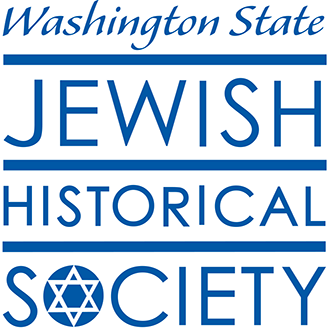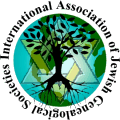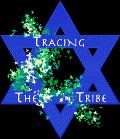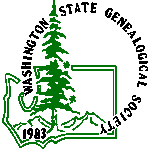Washington Jewish History
Histories of the Jewish Communities of Washington State
• Washington's Jewish Heritage (mostly Seattle), by Craig Degginger
• Tacoma's Jewish History, by Deb Freedman
• The History of the Jews of Bellingham, by Tim Baker
________________________________________
Washington's Jewish Heritage, by Craig Degginger
Who are the Jews of Washington state? First off, there are about 40,000 of us. We say "about," because the precise numbers are a bit sketchy. The last major demographic study conducted by the Jewish Federation of Greater Seattle, in 1990, showed there were an estimated 30,000 Jews in the greater Seattle area. Since then, there has been a continuing influx of newcomers, and that number is believed to have swelled to approximately 35,000. Add to that the estimated 5,000 Jews in the rest of the state, and we come to the number of "about" 40,000. But who was Jew number one? The first Jews, generally of German descent, settled in the Tacoma and Olympia area about the same time as the future State of Washington achieved territorial status in 1853. Although Washington state has never had a Jewish governor, Washington territory did in 1870, with the appointment of Edward Salomon. The first Jewish organization, the Hebrew Benevolent Society of Puget Sound, was founded in Olympia in 1873, and the Jewish cemetery in that city dates to that time. The first permanent Jewish settlers arrived in the village of Seattle in the 1860s, and by 1885 there were perhaps 100 Jewish families. Bailey Gatzert, the city's only Jewish mayor, was elected in 1876.
Many of Seattle's Eastern European Jews peddled wares, collected junk, worked as tailors or jewelers or owned second-hand stores. Jews had also migrated to Eastern Washington by this time. The town of Marcus, Washington was named for Jewish merchant B. Marcus Oppenheimer. The first High Holy Day services were held in Spokane in 1885. Jews from Poland and Russia made up the next wave of migration to Washington, fleeing poverty and violent anti-Semitism between 1880 and World War I. Sending for more relatives to join them in a new land, they made up the bulk of Seattle's 4,500 Jews in 1910. The first synagogue in Seattle was Ohaveth Sholum (Lovers of Peace), begun in 1889, but internal disputes over religious practices led to its downfall in 1896. Traditional Orthodox Jews founded Bikur Cholim Congregation, and Reform Jews founded Temple De Hirsch. The first Sephardic Jews-those who came from Turkey and the Isle of Rhodes and who spoke a unique language called Ladino-landed in Seattle in 1902. Expelled from Spain in 1492, now they fled the Ottoman Empire. The early Sephardim peddled fish and fruit. They joined their Ashkenazi brethren in living in the Yesler Way Cherry Street neighborhood of central Seattle. The Turkish Jews founded Sephardic Bikur Holim Congregation and the Jews of Rhodes began Congregation Ezra Bessaroth. Seattle now has the third largest concentration of Sephardim in the United States, numbering about 14 percent of the total Jewish population. It remains a strong, cohesive community. Rabbi Solomon Maimon, who served Sephardic Bikur Holim Congregation for 40 years, was the first Sephardic rabbi ordained in the United States. Seattle has produced more Sephardic rabbis than any other American city. Jews built small communities throughout the state during this time, including synagogues in Aberdeen, Bellingham, Centralia, Everett, Spokane and Tacoma.
Until after World War II, the Yesler-Cherry Street neighborhood served as the center of Seattle Jewish culture. A half dozen synagogues, the Talmud Torah school, and other organizational buildings were located here. An estimated 85 percent of the city's Jews lived in the area. But interestingly, the Sephardim and Ashkenazim often didn't mix socially despite living in the same neighborhood, occasionally aiming mild epithets at each other. In those days, intermarriage not only meant a union between Jew and gentile, but also between Ashkenazim and Sephardim. The old neighborhood began to break up after 1950, as the Seattle Jewish community began branching out to neighborhoods away from the inner city. The three Orthodox synagogues--Bikur Cholim (which later merged with Machzikay Hadath Congregation), Sephardic Bikur Holim, and Ezra Bessaroth--relocated to Seward Park. Herzl Congregation moved to Mercer Island and merged with a fledgling Bellevue congregation to become Herzl-Ner Tamid Conservative Congregation. Temple Beth Am, Reform, was founded in the North End along with Conservative Congregation Beth Shalom. Temple B'nai Torah was founded on Mercer Island, and now plans a move to larger quarters in Bellevue. Only Temple De Hirsch remained in the Central Area, but it too merged with another Bellevue congregation to become Temple De Hirsch Sinai, with sanctuaries on both sides of Lake Washington.
The growth in the community has led to some growing pains; nearly every Seattle-area synagogue listed in this guide is either running out of space or planning some kind of expansion in the next few years. Day schools are experiencing record enrollments. Experts say the booming increase in the state's Jewish population will continue, with more than 10,000 Jews expected to move to Washington in the next 20 years.
(Some material in this article is reprinted from “Coat of Many Colors, The History of Seattle's Jewish Community,” by Howard Droker, 1983.)
________________________________________
Tacoma's Jewish History, by Deb Freedman
Tacoma's Jewish community began with a few merchant families in Steilacoom in the 1860s (Isaac & Seraphina Pincus and Hyman and Louisa Goodtime) and a few in Olympia (Julius Coleman and Morris Dobrin.) By the 1870s Meyer Kaufman, Louis Levin and Louis Wolff had opened saloons such as the Pacific Hotel in what became Old Tacoma. The families joined to form a cemetery in Olympia--the Hebrew Benevolent Society of Puget Sound. The first graves were those of Morris Dobrin's daughter Celia, Meyer Kaufman's brother-in-law Robert Fischer, and Isaac Pincus' baby daughter Minnie. 1878 marked the arrival of the first Gross brothers, David and Ellis. Their store on New Tacoma's Pacific Avenue grew and they sent back to Poland for brothers Morris and Abe. Later they would employ innovative techniques such as organizing departments over several floors, hiring a nurse to care for infants while mothers shopped, and opening a free kindergarten for children of low-income families. They had meteorological instruments installed atop their store and ran the weather forecast at the head of their daily newspaper ad. Their brick store on 9th and "C" was eventually torn down to build the Pantages Theatre. By the early 1880s Tacoma had won the county seat and the terminus of the railroad. The Jewish population grew quickly. The wedding reception of Louis Wallerstein and his bride at the Tacoma hotel in 1884 was "one of the most fashionable affairs of the season," according to the Tacoma Daily Ledger.
Within a few years Jewish merchants dominated the male-oriented businesses on Tacoma's Pacific Avenue--cigar and tobacco shops, men's clothing, shoes and boots, and alcohol. They sold dry goods and wet goods. Charles Langert was a major wholesaler of liquor throughout the state. Albert Weinberg ran the Monogram Saloon. Charles Reichenbach, Mentein Cohn, Sam Gottschalk, Sol Jacoby, the Isaacs brothers, and the Gross brothers all had dry goods and clothing stores within a few blocks of each other, all technically in competition with each other, and they all prospered. By 1889 Tacoma organized its own cemetery--the FIRST Hebrew Benevolent Society. The women formed a branch of the Judith Montefiore Society to educate the children, and the Harmony Club was established--a social club that housed young bachelors, hosted dances, and provided a hall for high holidays. In 1892 Congregation Beth Israel was incorporated and services were first held in the new temple on 10th and "I" in the fall of 1893.
As Tacoma's Orthodox community grew, the Chevra Talmud Torah was organized in 1908. The Chevra Kadisha cemetery was created in 1914. In 1924 Chevra Talmud Torah purchased land at South 4th and "I." The synagogue was dedicated in 1930, and the name was later changed to Sinai Temple. Under Rabbi Baruch Treiger the congregation joined the conservative movement in 1938. In 1960, under the guidance of Rabbi Richard Rosenthal, the two temples merged and formed Temple Beth El.
________________________________________
The History of the Jews of Bellingham, by Tim Baker
Congregation Beth Israel has a rich heritage that dates back to the early 1900s. Fleeing from pogroms and restrictions in the Russian Pale of Settlement, Jews immigrated to the U.S. in vast numbers between 1880 and 1924. Among them were families from the shtetls of Skopishok and Rakishok, in northeastern Lithuania....
For the complete story, go to http://www.bethisrael.com.






